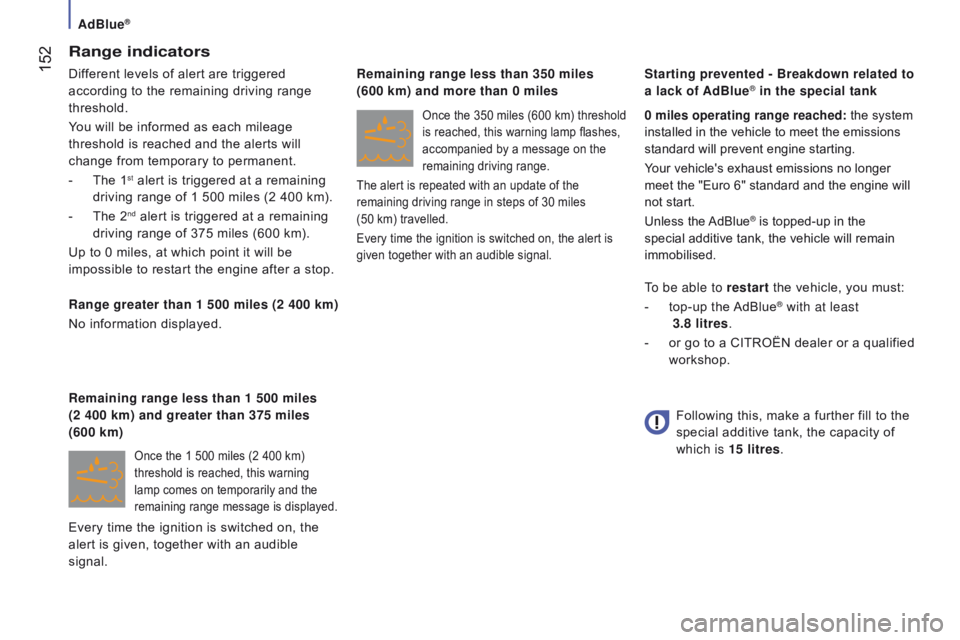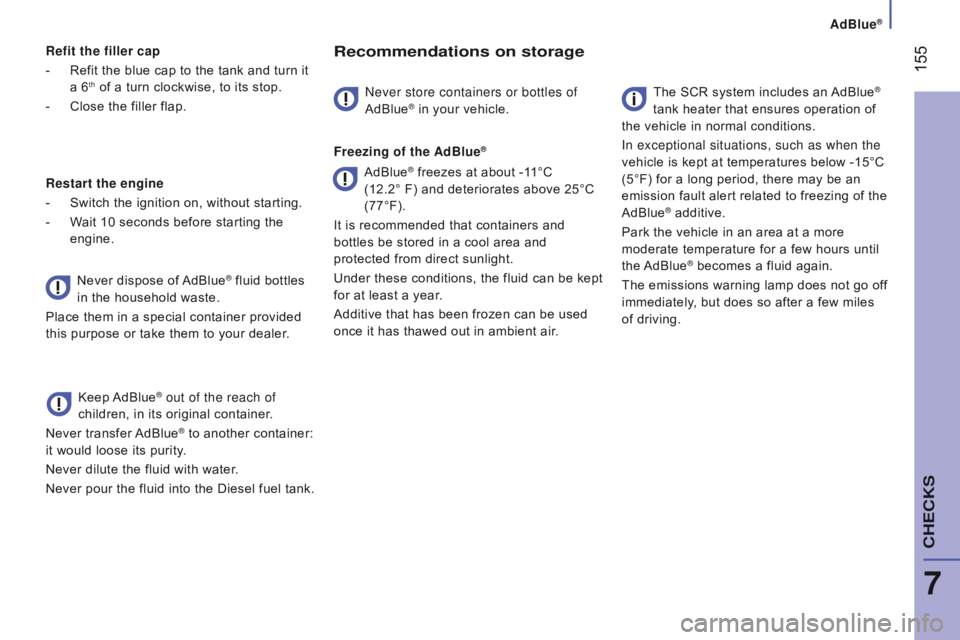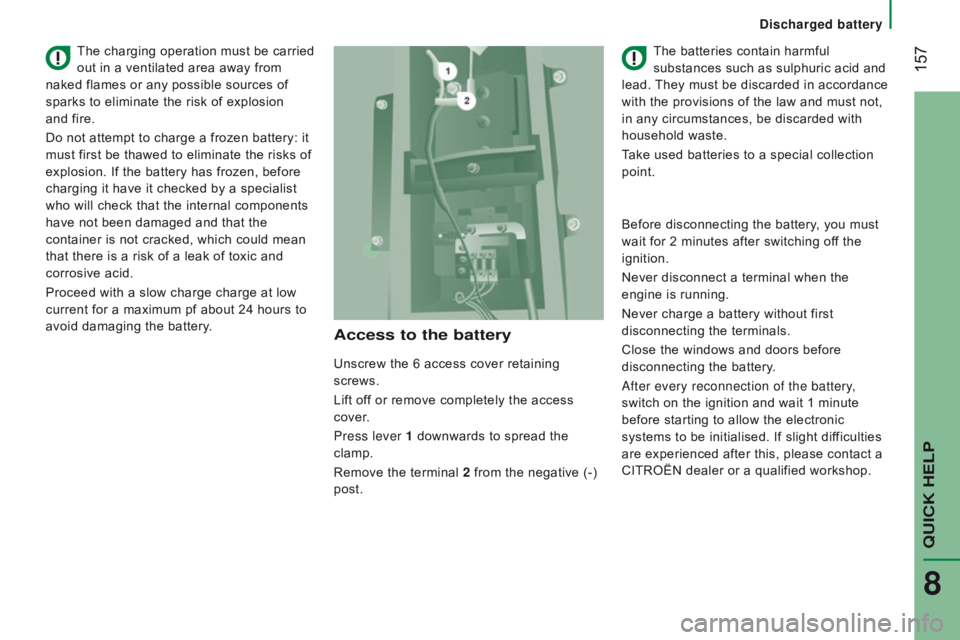CITROEN RELAY 2017 Handbook (in English)
Manufacturer: CITROEN, Model Year: 2017, Model line: RELAY, Model: CITROEN RELAY 2017Pages: 292, PDF Size: 9.04 MB
Page 151 of 292

149
FuEL SYS t EM cut- OFF
After the collision and before restore
these supplies, check that there is no
fuel leak or sparks, to avoid the risk of fire. In the event of a collision, a device
automatically cuts off the fuel supply
from the engine and cuts off the vehicle's
electrical supply
It triggers operation of the hazard warning
lamps and courtesy lamps, and unlocking of
the doors. To restore the fuel supply, press the first
button, located below the steering wheel.
Then to restore the electrical power
supply, press the second button, located
in the battery compartment under the front
passenger's floor (Minibus).
On other versions, the second button is
replaced by a fuse; contact a CITROËN
dealer or a qualified workshop.
7
cHEcKS
Fuel
Page 152 of 292

150
BLuEHdI And AdBLuE®
AdBlue® is the brand name of the solution
needed for operation of the SCR system.
This solution is a urea-based fluid.
This fluid is non-flammable, colourless and
odourless. BlueHDI vehicles have a specific AdBlue
®
additive tank with a capacity of 15 litres.
It has an exterior filler located behind the
fuel filler flap below the fuel filler cap and
closed with a blue filler cap.
The aim of BlueHDi is to reduce the
emissions of NOx (nitrous oxides) in the
air by up to 90%, using a system that
converts NOx into water vapour and nitrogen
in a dedicated catalytic converter: SCR
(Selective Catalytic Reduction).
This objective meets the "Euro 6" emissions
standard adopted by the European Union
aimed at limiting the emissions of pollutants
from internal combustion engines.
The SCR technology used on BlueHDi
engines involves the injection of AdBlue®
into the exhaust system.
Scr technology
AdBlue®
Page 153 of 292

151
This operation can also be carried out
by a CITROËN dealer or a qualified
workshop.
These bottles and containers are available
from CITROËN dealers. Filling the AdBlue tank
Filling of the AdBlue
® tank can be done
using:
-
5 or 10 litres containers equipped with a
10 centimetre filler tube or the filling kit
available from CITROËN dealers,
-
1.89 litre bottles that are screwed onto
the filler neck, available from CITROËN
dealers,
-
or when at a fuel filling station equipped
with a special AdBlue
® delivery pump for
heavy or light vehicles. Good practice
Once the AdBlue level drops to the reserve
level, you are warned by different temporary
signals (warning lamp, message, audible
signal).
When the AdBlue
® tank is empty,
restarting becomes impossible.
It is strongly recommended that you do not
wait for the successive alerts, but top-up the
AdBlue
® as soon as possible.
To facilitate filling, an adaptor is also
available from CITROËN dealers.
AdBlue®
7
cHEcKS
Page 154 of 292

152
range indicators
Different levels of alert are triggered
according to the remaining driving range
threshold.
You will be informed as each mileage
threshold is reached and the alerts will
change from temporary to permanent.
-
The 1st alert is triggered at a remaining
driving range of 1 500 miles (2 400 km).
-
The 2nd alert is triggered at a remaining
driving range of 375 miles (600 km).
Up to 0 miles, at which point it will be
impossible to restart the engine after a stop.
r
ange greater than 1 500 miles (2 400 km)
No information displayed.
Once the 1 500 miles (2 400 km)
threshold is reached, this warning
lamp comes on temporarily and the
remaining range message is displayed.
remaining range less than 1 500 miles
(2 400 km) and greater than 375 miles
(600 km)
Once the 350 miles (600 km) threshold
is reached, this warning lamp flashes,
accompanied by a message on the
remaining driving range.
The alert is repeated with an update of the
remaining driving range in steps of 30 miles
(50 km) travelled.
Every time the ignition is switched on, the alert is
given together with an audible signal.0 miles operating range reached: the system
installed in the vehicle to meet the emissions
standard will prevent engine starting.
Your vehicle's exhaust emissions no longer
meet the "Euro 6" standard and the engine will
not start.
Unless the AdBlue
® is topped-up in the
special additive tank, the vehicle will remain
immobilised.
To be able to restart the vehicle, you must:
-
top-up the
AdBlue® with at least
3.8 litres.
-
or
go to a CITROËN dealer or a qualified
workshop.
r
emaining range less than 350 miles
(600 km) and more than 0 miles Starting prevented - Breakdown related to
a lack of AdBlue
®
in the special tank
Following this, make a further fill to the
special additive tank, the capacity of
which is 15 litres.
Every time the ignition is switched on, the
alert is given, together with an audible
signal.
AdBlue®
Page 155 of 292

153
Fault with the Scr system
The diagnostic warning lamp
comes on.
Every time the ignition is
switched on, the emissions fault
is confirmed by an audible signal and a
message.
If it is a temporary fault, the alert disappears
as soon as the exhaust emissions return to
the levels required by the standard. Fault confirmed
In addition to the previous signals, the
remaining range allowed will be displayed in
miles (kilometres) in the instrument panel.
The alert will be repeated every 30 seconds
with an update of the driving range.
Go to a CITROËN dealer or a qualified
workshop as soon as possible.
You risk not being able to start the engine.
Starting prevented, having covered the
250 miles (400 km)
d
etection
At each attempt at starting,
the alert is activated and the
message on starting prevention is
displayed.
On the other hand, if the warning lamp
is still on after 30 miles (50 km) of
driving, the fault is confirmed.
An engine start prevention system
will be activated automatically after
250
miles (400 km) travelled following this
confirmation.
Go to a CITROËN dealer or a qualified
workshop.
AdBlue®
7
cHEcKS
Page 156 of 292

154
refilling / topping-up the
AdBlue®
Precautions to take
To facilitate filling, an adaptor is
available from CITROËN dealers. Park the vehicle
-
Before topping-up, ensure that the
vehicle is parked on a flat and level
surface.
Open the filler
-
Open the fuel filler flap.
-
T
urn the blue cap a 6
th of a turn anti-
clockwise.
-
Remove the blue cap downwards.
top-up
-
Obtain a bottle of
AdBlue
®. After first
checking the use-by date, read carefully
the instructions on use on the label
before pouring the contents of the bottle
into your vehicle's AdBlue
® tank.
Important: if your vehicle's
AdBlue
® tank is completely empty -
which is confirmed by the alert messages
and the impossibility of starting the engine,
you must add at least 3.8 litres
(so two 1.89 litre bottles).
-
After emptying the bottle, wipe away any
spillage around the tank filler using a
damp cloth.
If any fluid is split or splashed, wash
immediately with cold water or wipe
with a damp cloth.
If the fluid has crystallised, clean it off using
a sponge and hot water.
Use only AdBlue
® that meets
the ISO 22241 standard.
Please check the use-by date.
Read the instructions on the label.
Ensure that you have a suitable filler pipe,
which may or may not be supplied with the
container.
AdBlue®
Page 157 of 292

155
refit the filler cap
-
Refit the blue cap to the tank and turn it
a 6
th of a turn clockwise, to its stop.
-
Close the filler flap.
r
estart the engine
-
Switch the ignition on, without starting.
-
W
ait 10 seconds before starting the
engine.
Keep AdBlue
® out of the reach of
children, in its original container.
Never transfer AdBlue
® to another container:
it would loose its purity.
Never dilute the fluid with water.
Never pour the fluid into the Diesel fuel tank.
recommendations on storage
Never store containers or bottles of
AdBlue® in your vehicle.
Freezing of the AdBlue
®
The SCR system includes an AdBlue®
tank heater that ensures operation of
the vehicle in normal conditions.
In exceptional situations, such as when the
vehicle is kept at temperatures below -15°C
(5°F) for a long period, there may be an
emission fault alert related to freezing of the
AdBlue
® additive.
Park the vehicle in an area at a more
moderate temperature for a few hours until
the AdBlue
® becomes a fluid again.
The emissions warning lamp does not go off
immediately, but does so after a few miles
of driving.
Never dispose of AdBlue® fluid bottles
in the household waste.
Place them in a special container provided
this purpose or take them to your dealer.
AdBlue® freezes at about -11°C
(12.2° F) and deteriorates above 25°C
(77°F).
It is recommended that containers and
bottles be stored in a cool area and
protected from direct sunlight.
Under these conditions, the fluid can be kept
for at least a year.
Additive that has been frozen can be used
once it has thawed out in ambient air.
AdBlue®
7
cHEcKS
Page 158 of 292

156
A. Positive metal point on your vehicle
B.
Slave battery
c
.
Earth on your vehicle
The positive metal point
A is accessible by a
flap, located on the side of the fusebox.
Make connections only to the points
indicated and illustrated above. Failure
to observe this instruction introduces
the risk of short-circuit!Starting from another
battery
B
A
tt
E
r
Y
c
harging the battery using a
charger
- Connect the red cable to the metal
point
A then to the positive (+) terminal
of the slave battery B .
-
Connect one end of the green or black
cable to the negative (-) terminal of the
slave battery B .
-
Connect the other end of the green or
black cable to the earth point
c
on your
vehicle.
-
Operate the starter
, let the engine run.
-
W
ait for the engine to return to idle, then
disconnect the cables. -
Go to the battery located in the front
left floor.
-
Disconnect the battery
.
-
Follow the instructions for use given by
the battery charger manufacturer.
-
Reconnect starting with the negative (-)
terminal.
-
Check that the terminals and connectors
are clean. If they are covered with
sulphate (white or greenish deposit),
disconnect them and clean them.
discharged battery
Page 159 of 292

157
Access to the battery
Unscrew the 6 access cover retaining
screws.
Lift off or remove completely the access
cover.
Press lever 1 downwards to spread the
clamp.
Remove the terminal 2 from the negative (-)
post. The batteries contain harmful
substances such as sulphuric acid and
lead. They must be discarded in accordance
with the provisions of the law and must not,
in any circumstances, be discarded with
household waste.
Take used batteries to a special collection
point.
The charging operation must be carried
out in a ventilated area away from
naked flames or any possible sources of
sparks to eliminate the risk of explosion
and
fire.
Do not attempt to charge a frozen battery: it
must first be thawed to eliminate the risks of
explosion. If the battery has frozen, before
charging it have it checked by a specialist
who will check that the internal components
have not been damaged and that the
container is not cracked, which could mean
that there is a risk of a leak of toxic and
corrosive acid.
Proceed with a slow charge charge at low
current for a maximum pf about 24 hours to
avoid damaging the battery. Before disconnecting the battery, you must
wait for 2 minutes after switching off the
ignition.
Never disconnect a terminal when the
engine is running.
Never charge a battery without first
disconnecting the terminals.
Close the windows and doors before
disconnecting the battery.
After every reconnection of the battery,
switch on the ignition and wait 1 minute
before starting to allow the electronic
systems to be initialised. If slight difficulties
are experienced after this, please contact a
CITROËN dealer or a qualified workshop.
discharged battery
QuIcK HELP
8
Page 160 of 292

158
The presence of this label, in particular
with the Stop & Start system, indicates
the use of a 12 V lead-acid battery with
special technology and specification;
the involvement of a CITROËN dealer or
a qualified workshop is essential when
replacing or disconnecting the battery.
After refitting the battery by a
CITROËN dealer or a qualified
workshop, the Stop & Start system will
only be active after a continuous period of
immobilisation of the vehicle, a period which
depends on the climatic conditions and the
state of charge of the battery (up to about
8 hours).
It is advisable to disconnect the
negative (-) terminal of the battery
if the vehicle is not to be used for a
period of more than one month.
The description of the battery charging
procedure is given as an indication only.
If the battery has been disconnected
for some time, it may be necessary to
reinitialise the following functions:
-
the display parameters (date,
time, language, distance unit and
temperature
unit),
-
the radio stations,
-
the central locking.
Some settings are cleared and must be
reprogrammed, consult a CITROËN.
If your vehicle is fitted with a tachograph or
an alarm, disconnection of the negative (-)
terminal of the battery (located under the
floor on the left-hand side, in the cab) is
recommended if the vehicle is not to be used
for a period of more than 5 days.
Discharged battery